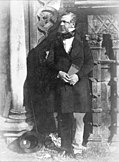English: The ancient City of Tiberias, built by Herod Antipas, and named in honour of
his patron, the Emperor Tiberius, has long since perished. With the mixture of
violence and policy which characterised the Oriental governments, Herod compelled
a population from the surrounding provinces to fill his City ; adorned it with structures,
of which the very fragments are stately ; gave it peculiar privileges ; and building
a palace which was one of the wonders of the land, declared Tiberias the capital
of Galilee. 1 The ruins in the Sketch are those of the modern City prostrated
by the earthquake.
The view commands various sites, memorable from their connexion with Scripture.
On the West coast lies El-Medgel, the site of Magdala, the City of Mary Magdalene ;
Capernaum, Chorazin, and Bethsaida, once lay on the same coast; and in the vicinity,
more to the South, was the City of Tarichaea. On the East coast was the scene
of the great miracle, the feeding of the four thousand ; and in the horizon is the
majestic Hermon, 10,000 feet above the Mediterranean.
The Rabbins held that the former City stood on the site of Rakkath, while
Jerome records a tradition that it was once Chinnereth; 5 but, leaving those laborious
triflings to their natural obscurity, it is evident that the original Tiberias occupied
a site farther to the north. There the ground is still strewed with fragments of
noble architecture, — baths, temples, and perhaps theatres ; giving fidl proof of a Capital
raised with the lavish grandeur of a Herodian City. In the great, final war, which
extinguished Judali as a nation, and commenced the longest calamity of the most
illustrious and unhappy race of mankind, Tiberias escaped the general destruction.
Submitting to the authority of Vespasian, without waiting to be subdued by his
arms, the City retained its population, and, probably, its privileges. In the national
havoc, it even acquired the additional wealth and honours of a City of Refuge.
It had a coinage of its own, exhibiting the effigies of several of the Emperors,
down to Antoninus Pius. It appears to have peculiarly attracted Imperial notice,
for Hadrian, though pressed with the cares of the Roman world, commenced the
rebuilding of a temple, or palace, which had been burnt in an insurrection.
But the history of this beautiful City has a still higher claim on human recollection,
as the last retreat of Jewish literature. On the fall of Jerusalem, and the final
expulsion of the Jews from the central province, the chief surviving portion of the
state, the rank, the wealth, and the learning, were suffered to take shelter within the
walls of Tiberias. In the second century, a Sanhedrim was formed there, and the
broken people made their last attempt to form a semblance of established government,
The two great Hebraists, Buxtorf and Lightfoot, have given the history of the
School of Tiberias, more interesting than the details of massacre, or the description of
ruins. The protection of the City drew the principal scholars from the cells and
mountains where they had concealed themselves from the habitual severities of Rome.
Under the presidency of Rabbi Judah Hakkodesh the School flourished, and acquired
the acknowledged title of the Capital of Jewish learning. The first natural enterprise
of such a School was the collection of the ancient interpretations and traditions of the
Law ; and those were embodied by Rabbi Judab in the Mishna (about a.d. 220).
In the third century, Rabbi Jocbanan compiled the Gemara, a supplement to the
Mishna (about a.d. 270), now known as the Jerusalem Talmud. In the sixth century,
the Babylonian Jews also compiled a Gemara, named the Talmud of Babylon, now
more esteemed by the Jews. But the School of Tiberias is said also to have
produced the Masora, or Canon for preserving the purity of the text in the Old
Testament, — a labour whose value, however the subject of controversy, is admitted
to be incontrovertible.
The civil history of Tiberias is the common recapitulation of Eastern sieges and
slaughters. Fortified by Justinian, it fell successively into the hands of the Saracens,
the Crusaders, Saladin, the Syrians, 1 and the Turks. The French invasion brought
Tiberias into European notice once more (a.d. 1799). On their retreat it sank into
its old obscurity, and must wait another change, of good or evil fortune, to be
known.




